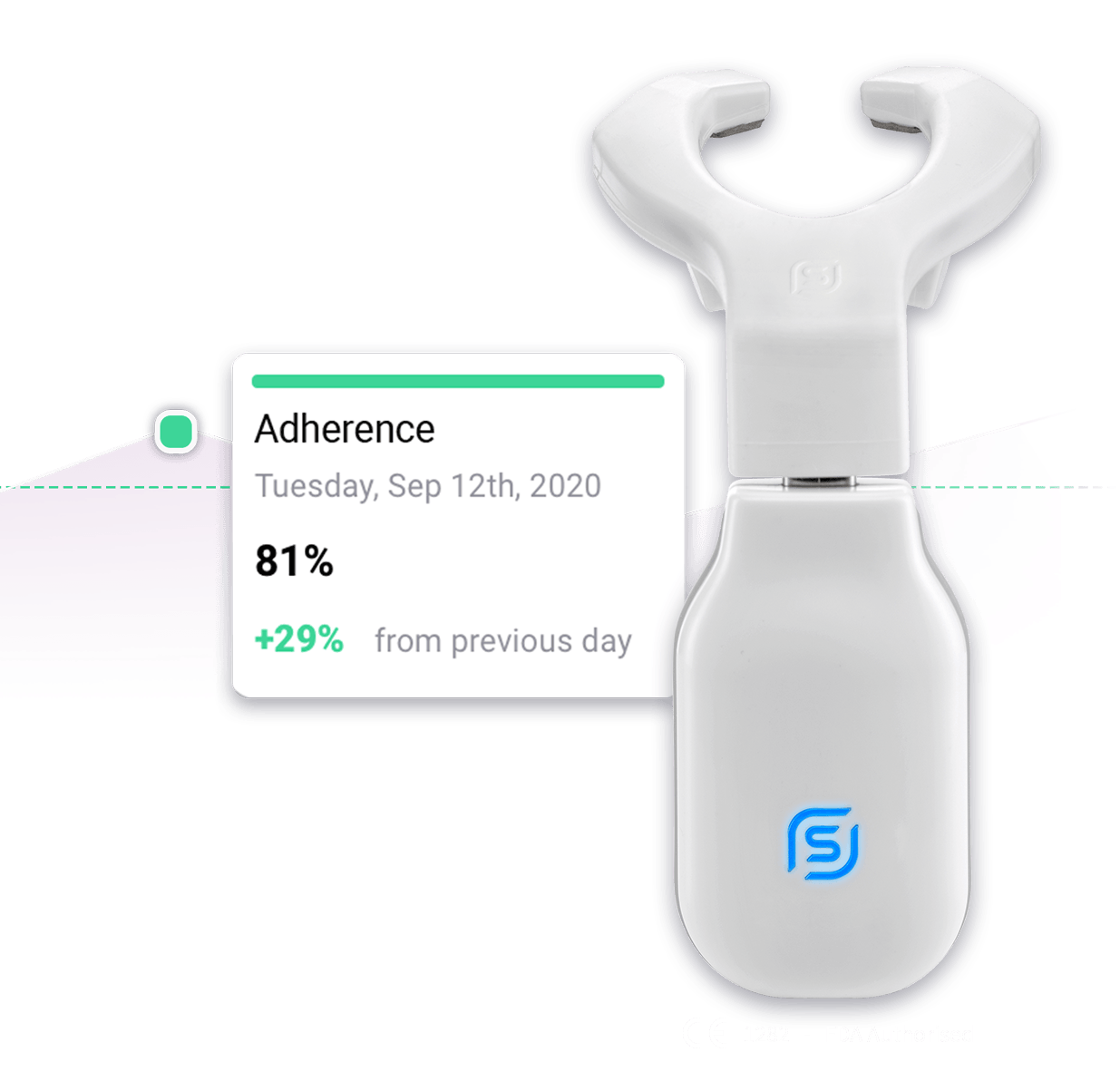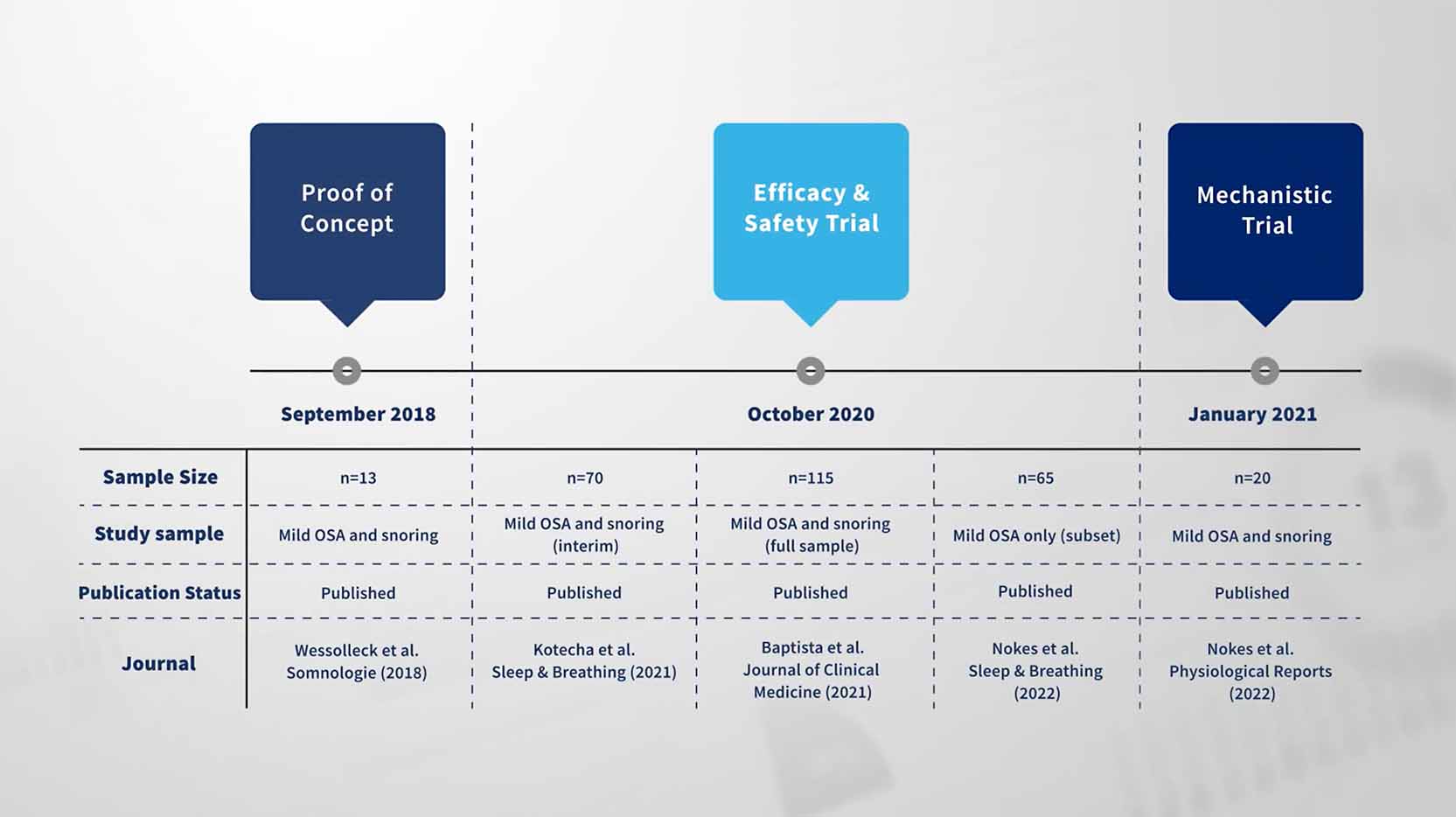Clinical Evidence
A wide body of evidence substantiates the efficacy of eXciteOSA and underpins NMES in sleep disordered breathing. Dive into the research that speaks to its benefits by reviewing our studies and relevant materials.
NMES & The genioglossus
A new approach to OSA
Obstructive sleep apnea
and the genioglossus
Obstructive sleep apnea (OSA) is characterized by repetitive episodes of upper airway obstruction. An underlying determinant of OSA is loss of upper airway muscle tone during sleep and lack of compensatory response by the genioglossus and surrounding muscles to unblock the compromised airway. Continuous positive airway pressure (CPAP) is the current gold standard therapy for OSA, but its effectiveness is limited by poor patience adherence.
NMES retrains
deconditioned muscles
Neuromuscular Electrical Stimulation (NMES) is a proven medical therapy that uses a device to electrically stimulate nerves, causing muscle contractions. This electrical stimulation increases range of motion, offsetting the effects of disuse or paralysis. It’s used widely to ‘retrain’ a muscle to function after surgery or period of disuse.
Connecting the dots
leads to new OSA therapy
Improving genioglossus and upper airway activity is proven to have a positive effect on OSA and Primary Snoring. NMES is proven to retrain muscle function and build muscle tone (endurance). Marrying the two introduces a new approach to OSA: intraoral NMES. eXciteOSA targets upper airway dilator muscles supporting the airway to provide a patient friendly awake-state therapy that physiologically addresses OSA and Primary Snoring.
eXciteOSA
The world’s first clinically proven NMES therapy that reduces mild OSA and primary snoring.
- 52% reduction in AHI
- 50% reduction in ODI
- 3.9 point reduction in ESS

How It Works
Neuromuscular electrical stimulation (NMES) with eXciteOSA®

In 2018, building upon the decades of research in Sleep and in NMES, the eXciteOSA clinical story began with a proof of concept trial. The latest mechanistic trial at UC San Diego succeeded a recent European multi-center trial of 115 patients. The results give confidence to the efficacy of this novel approach to sleep disordered breathing. Watch the video to learn more.
NMES in Medicine
NMES is well proven to restore, rehabilitate and improve muscle function
Neuromuscular electrical stimulation (NMES) produces regular contractions of paralyzed muscles and can produce changes, such as blood flow and muscle size, in regularly stimulated muscles that may increase the health of the target muscle and surrounding soft tissues (Taylor et al., 1993)
Neuromuscular Electrical Stimulation Applications
ABSTRACT: Neuromuscular electrical stimulation (NMES) of paralyzed muscles can be used to restore or replace motor function in individuals who have upper motor neuron damage from causes such as stroke or spinal cord injury (SCI). In some conditions, such as stroke or incomplete SCI, NMES may be part of a therapy regimen that helps restore volitional movement and function.
The Neurological Hand
ABSTRACT: NMES/FES is often used with the neurological hand. Functional electrical stimulation (FES) refers to the application of NMES to help achieve a functional task. FES is a technique that uses bursts of short electrical pulses to generate muscle contraction by stimulating motor neurons or reflex pathways. Three forms of NMES are available: 1) cyclic, 2) electromyogram (EMG); and 3) neuro prosthetic applications of NMES, which can ultimately improve or restore the grasp and manipulation functions required for typical activities of daily life.
Muscle Weakness
ABSTRACT: Neuromuscular electrical stimulation (NMES) can be an effective component of a rehabilitation program for muscle weakness. NMES can help when the client is either unable or unwilling to volitionally elicit strong muscle contractions. NMES has been shown to accelerate functional recovery after surgery, prevent disuse atrophy, reduce range of motion deficits, and improve motor control in patients with strength deficits of various etiologies.
Architecture of muscle tissue and its adaptation to pathological conditions
ABSTRACT: Karabay et al. investigated the effect of NMES on tibialis anterior muscle architecture in children with cerebral palsy. NMES was applied to the muscle 30 minutes, 5 days per week for 4 weeks. Twenty-five hertz frequency and 250 µm duration were chosen. Only physiological cross-sectional area was higher after NMES. Other parameters including pennation angle and fascicle length did not change (Karabay et al., 2015).
Are you ready to offer your patients a therapy that is simple, convenient and clinically proven?
Find out how easy it is to integrate eXciteOSA into your treatment continuum for primary snoring and mild OSA.
If you are an existing eXciteOSA patient, please contact us here.
References
- Wessolleck, E., Bernd, E., Dockter, S. et al. Intraoral electrical muscle stimulation in the treatment of snoring. Somnologie 22, 47–52 (2018). https://doi.org/10.1007/s11818-018-0179-z
- Kotecha, B., Wong, P.Y., Zhang, H. et al. A novel intraoral neuromuscular stimulation device for treating sleep-disordered breathing. Sleep Breath (2021). https://doi.org/10.1007/s11325-021-02355-7
- Baptista, Peter M., Paula Martínez Ruiz de Apodaca, Marina Carrasco, Secundino Fernandez, Phui Y. Wong, Henry Zhang, Amro Hassaan, and Bhik Kotecha. 2021. “Daytime Neuromuscular Electrical Therapy of Tongue Muscles in Improving Snoring in Individuals with Primary Snoring and Mild Obstructive Sleep Apnea” Journal of Clinical Medicine 10, no. 9: 1883. https://doi.org/10.3390/jcm10091883
- Data on File. Signifier Medical Technologies, 2021
*See For Sleep Apnea page

